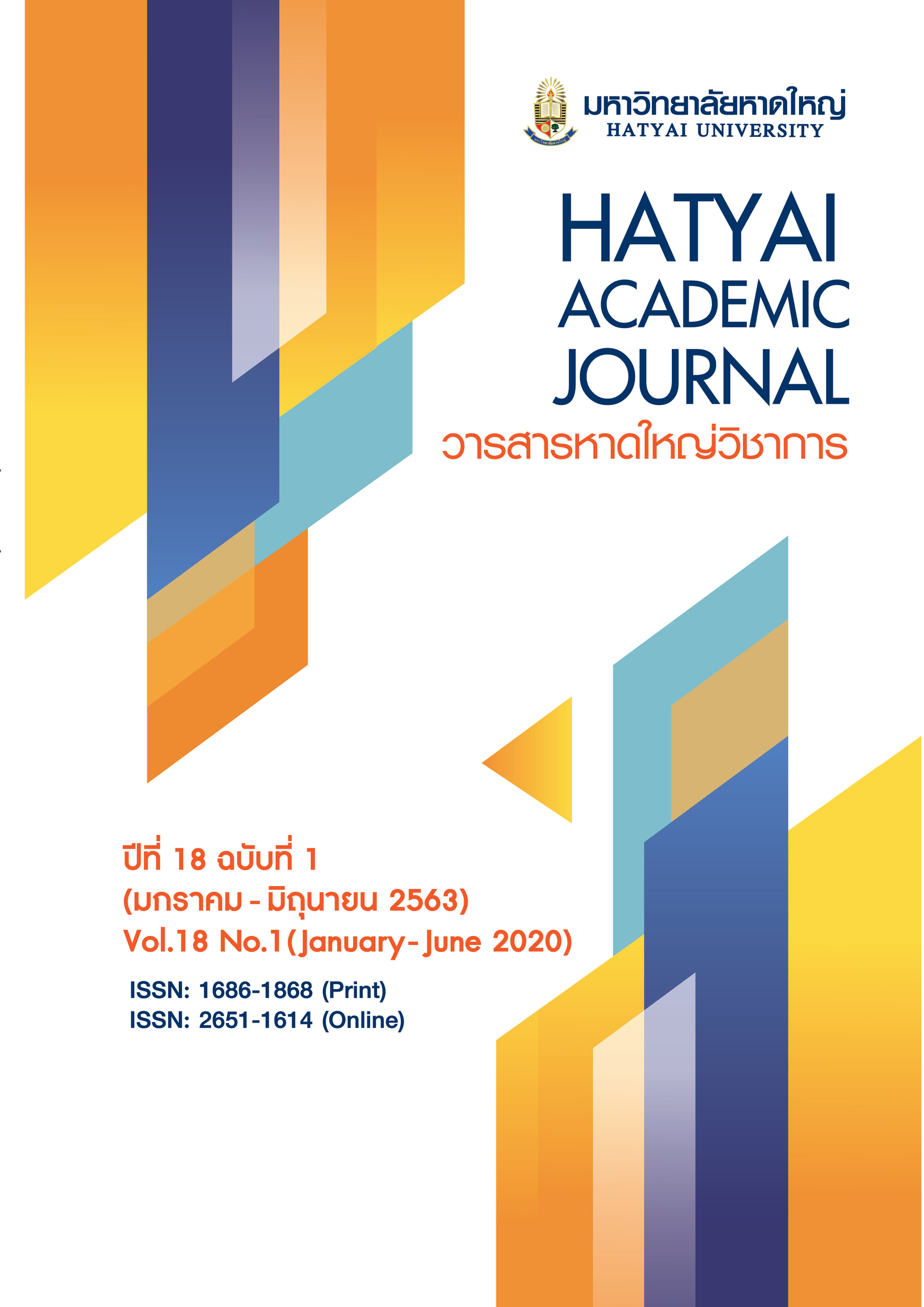The Approach of Daily Life Pedestrian Behavior for Urban Development in Hat Yai City
Main Article Content
Abstract
The aim of this paper is to study pedestrian behavior for urban development in Hat Yai City using quantitative and qualitative methods. The behaviors were codified following a standardized observation. The result showed that the first behavior was walking (58.5%). The frequency of walking was 23.5%, and the purpose was to go shopping (38.5%). The length of walks was less than 500 meters (23.5%) with less than 15 minutes spent (19.8%). The top three problems and obstacles were the feeling of insecurity (afraid of car crashes), parking on footpaths, and toxic pollution (dust and exhaust fumes). The smallest problem or obstacle was being insulted because of being poor.
The approaches for developing pedestrians were adding lighting to pedestrian areas, adding crosswalks and traffic lights, providing sidewalks for the disabled and people in wheelchairs, providing pedestrian paths in some places where pedestrian paths are still deficient, providing ready-to-use pavilions for sidewalk shelters, and repairing the sidewalks which are damaged.
Article Details
All published articles are evaluated by three qualified peer reviewers from various institutions through a double-blind process, where reviewers do not know the authors’ identities and authors do not know the reviewers’ identities. The content and articles in the Hatyai Academic Journal reflect the authors’ views only and are neither the opinions of the editorial board nor the responsibility of Hatyai University. The Editorial Board of the Hatyai Academic Journal allows articles to be reproduced for academic purposes, on the condition that the original source is clearly cited.
References
A-Seven Corporation Company Limited. (2016). Master plan for landscape development and specific area planning. Songkhla: Hatyai City Municipality. [in Thai]
Bhandhasu, E., & Bejrananda, M. (2013). Travel behavior in regional city: A case study of Chiang-Mai city. Academic Journal: Faculty of Architecture, Khon Kaen University, 10(1), 74-91. [in Thai]
Boonyoo, T. (2005). Guidelines for development of bicycle system in regional city. Retrieved from http://www.thaicyclingclub.org/sites/default/files/19_ephynphaa.pdf [in Thai]
Cervero, R. (1996). Jobs-housing balance revisited. Journal of the American Planning Association, 62(4), 492-511.
Chaiboonrueng, T. (2012). Walkability assesment in Chiang Mai University. Retrieved from http://civil.eng.cmu.ac.th/research/in/2555/2486 [in Thai]
Chaowarat, P., & Piriyakarnnon, M. (2013). Walking and bicycling promotion, Mahasarakham University, Kamriang Campus. Retrieved from http://www.thaicyclingclub.org/content/general/knowledge/detail/1715 [in Thai]
Dechpichai, W. (1992). A guide to research and evaluate of educational and behavioral science. Pattani: Montriboriharn. [in Thai]
Department of Land Transport. (2017). Number of registered vehicles. Retrieved from http://apps.dlt.go.th/statistics_web/statistics.html [in Thai]
Hatyai City Municipality. (2017). Population statistics year 2017. Retrieved from www.hatyaicity.go.th [in Thai]
Khohong City Municipality. (2017). Population statistics year 2017. Retrieved from www.khohongcity.go.th [in Thai]
Khuabphimai, C. (2013, March 29-30). Design guideline for footpath in main city of region: Case study Nakhonratchasima Municipality. In The 1st Thailand Bike and Walk Forum. Thailand Cycling Club, Bangkok. [in Thai]
Kinkajorn, K., Tretrakarn, T., & Angkasuwapala, T. (2012). A survey of pedestrian users in the suburbs Sample area of Lat Krabang. Retrieved from http://www.thaicyclingclub.org/ content/general/knowledge/detail/756 [in Thai]
Konisranukul, W. (2013, March 29-30). Guidelines for the development of the environment to promote urban walking in urban areas. In The 1st Thailand Bike and Walk Forum. Thailand Cycling Club, Bangkok. [in Thai]
Leopairojna, S. K. (2012). Improving access to public transportation for canalside communities near Kasetsart University, Bangkhen. Journal of Architectural/Planning Research and Studies, 8(2), 27-49. [in Thai]
Luadsakul, C. (2012). The study of walkability index: A case study of Nakhon Rachasima Municipality (Master dissertation). Suranaree University of Technology, Nakhon Rachasima. [in Thai]
Modus Consultant Company Limited. (2018). Planning and development plan for a specific area to support the expansion of Hat Yai city, Songkhla. Bangkok: Department of Public Works and Town and Country Planning. [in Thai]
Nuworsoo, C., & Cooper, E. (2012). Considerations for integrating bicycling and walking facilities into urban infrastructure. Retrieved from http://docs.trb.org/prp/13-3997.pdf
Papadimitriou, E., Theofilatos, A., & Yannis, G. (2013). Patterns of pedestrian attitudes, perceptions and behaviour in Europe. Safety Science, 53(3), 114–122.
Sangsila, S. (2012). The pedestrain behavior of community around mass rapid transit station (Master dissertation). Silpakorn University, Nakornpratom. [in Thai]
Stead, D. (2001). Relationships between land use, socioeconomic factors, and travel patterns in Britain. Planning and Design, 28(4), 499-528.
Thavornyutikarn, P. (2007). Sidewalks in Chiang Mai. Retrieved from http://www.oknation.net/blog/udif/2009/10/20/entry-1 [in Thai]
Tuaycharoen, N., & Konisranukul, W. (2013, March 29-30). Factors affecting walkway utilization of elderly pedestrian in urban area: Streetscape, walkway quality and walking behavior. In The 1st Thailand Bike and Walk Forum. Thailand Cycling Club, Bangkok. [in Thai]
Varet, S. (2013). Effect of walking exercise on body mass index and fat percentage of the overweight secondary student’s (Master’ thesis). Srinakharinwirot University, Bangkok. [in Thai]
Woodward, A., Hales, S., & Hill, S. E. (2002). The motor car and public health: Are we exhausting the environment?. Medical Journal of Australia, 177(11), 592-593.
Yamane, T. (1967). Statistics: An introductory analysis (2 nd ed.). New York: Harper and Row.

